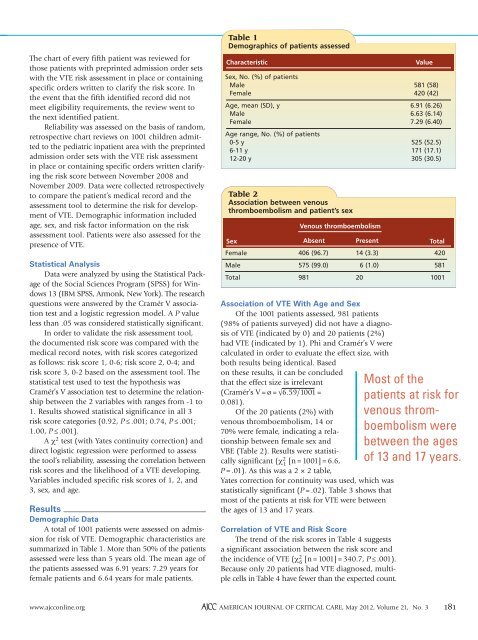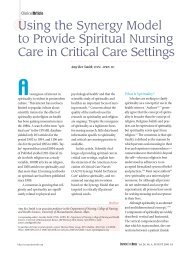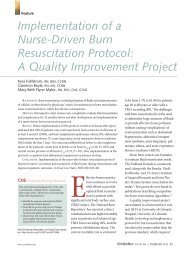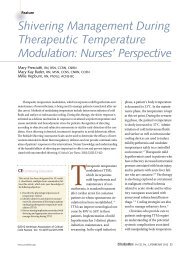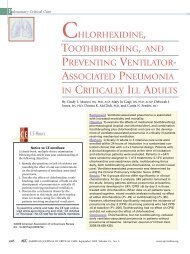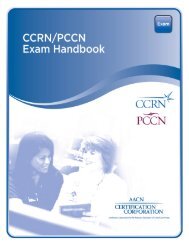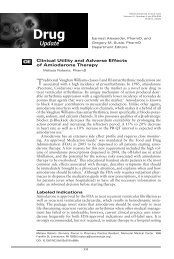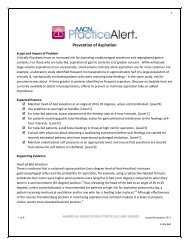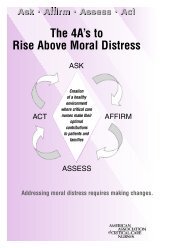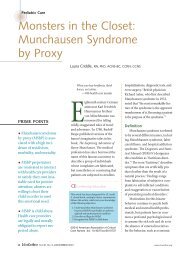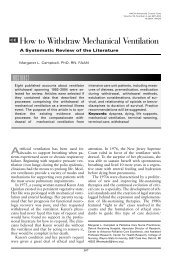Early Recognition of Pediatric Venous Thromboembolism: A Risk ...
Early Recognition of Pediatric Venous Thromboembolism: A Risk ...
Early Recognition of Pediatric Venous Thromboembolism: A Risk ...
You also want an ePaper? Increase the reach of your titles
YUMPU automatically turns print PDFs into web optimized ePapers that Google loves.
The chart <strong>of</strong> every fifth patient was reviewed for<br />
those patients with preprinted admission order sets<br />
with the VTE risk assessment in place or containing<br />
specific orders written to clarify the risk score. In<br />
the event that the fifth identified record did not<br />
meet eligibility requirements, the review went to<br />
the next identified patient.<br />
Reliability was assessed on the basis <strong>of</strong> random,<br />
retrospective chart reviews on 1001 children admitted<br />
to the pediatric inpatient area with the preprinted<br />
admission order sets with the VTE risk assessment<br />
in place or containing specific orders written clarifying<br />
the risk score between November 2008 and<br />
November 2009. Data were collected retrospectively<br />
to compare the patient’s medical record and the<br />
assessment tool to determine the risk for development<br />
<strong>of</strong> VTE. Demographic information included<br />
age, sex, and risk factor information on the risk<br />
assessment tool. Patients were also assessed for the<br />
presence <strong>of</strong> VTE.<br />
Statistical Analysis<br />
Data were analyzed by using the Statistical Package<br />
<strong>of</strong> the Social Sciences Program (SPSS) for Windows<br />
13 (IBM SPSS, Armonk, New York). The research<br />
questions were answered by the Cramér V association<br />
test and a logistic regression model. A P value<br />
less than .05 was considered statistically significant.<br />
In order to validate the risk assessment tool,<br />
the documented risk score was compared with the<br />
medical record notes, with risk scores categorized<br />
as follows: risk score 1, 0-6; risk score 2, 0-4; and<br />
risk score 3, 0-2 based on the assessment tool. The<br />
statistical test used to test the hypothesis was<br />
Cramér’s V association test to determine the relationship<br />
between the 2 variables with ranges from -1 to<br />
1. Results showed statistical significance in all 3<br />
risk score categories (0.92, P ≤ .001; 0.74, P ≤ .001;<br />
1.00, P ≤ .001).<br />
A χ 2 test (with Yates continuity correction) and<br />
direct logistic regression were performed to assess<br />
the tool’s reliability, assessing the correlation between<br />
risk scores and the likelihood <strong>of</strong> a VTE developing.<br />
Variables included specific risk scores <strong>of</strong> 1, 2, and<br />
3, sex, and age.<br />
Results<br />
Demographic Data<br />
A total <strong>of</strong> 1001 patients were assessed on admission<br />
for risk <strong>of</strong> VTE. Demographic characteristics are<br />
summarized in Table 1. More than 50% <strong>of</strong> the patients<br />
assessed were less than 5 years old. The mean age <strong>of</strong><br />
the patients assessed was 6.91 years: 7.29 years for<br />
female patients and 6.64 years for male patients.<br />
Table 1<br />
Demographics <strong>of</strong> patients assessed<br />
Characteristic<br />
Sex, No. (%) <strong>of</strong> patients<br />
Male<br />
Female<br />
Age, mean (SD), y<br />
Male<br />
Female<br />
Age range, No. (%) <strong>of</strong> patients<br />
0-5 y<br />
6-11 y<br />
12-20 y<br />
Table 2<br />
Association between venous<br />
thromboembolism and patient’s sex<br />
Sex<br />
Female<br />
Male<br />
Total<br />
<strong>Venous</strong> thromboembolism<br />
Absent<br />
406 (96.7)<br />
575 (99.0)<br />
981<br />
Present<br />
14 (3.3)<br />
6 (1.0)<br />
20<br />
Association <strong>of</strong> VTE With Age and Sex<br />
Of the 1001 patients assessed, 981 patients<br />
(98% <strong>of</strong> patients surveyed) did not have a diagnosis<br />
<strong>of</strong> VTE (indicated by 0) and 20 patients (2%)<br />
had VTE (indicated by 1). Phi and Cramér’s V were<br />
calculated in order to evaluate the effect size, with<br />
both results being identical. Based<br />
on these results, it can be concluded<br />
that the effect size is irrelevant<br />
(Cramér’s V = ø = √6.59/1001 =<br />
0.081).<br />
Of the 20 patients (2%) with<br />
venous thromboembolism, 14 or<br />
70% were female, indicating a relationship<br />
between female sex and<br />
VBE (Table 2). Results were statistically<br />
significant (χ 2 1<br />
[n = 1001] = 6.6,<br />
P = .01). As this was a 2 × 2 table,<br />
Yates correction for continuity was used, which was<br />
statistically significant (P = .02). Table 3 shows that<br />
most <strong>of</strong> the patients at risk for VTE were between<br />
the ages <strong>of</strong> 13 and 17 years.<br />
Correlation <strong>of</strong> VTE and <strong>Risk</strong> Score<br />
The trend <strong>of</strong> the risk scores in Table 4 suggests<br />
a significant association between the risk score and<br />
the incidence <strong>of</strong> VTE (χ 2 6<br />
[n = 1001] = 340.7, P ≤ .001).<br />
Because only 20 patients had VTE diagnosed, multiple<br />
cells in Table 4 have fewer than the expected count.<br />
Value<br />
581 (58)<br />
420 (42)<br />
6.91 (6.26)<br />
6.63 (6.14)<br />
7.29 (6.40)<br />
525 (52.5)<br />
171 (17.1)<br />
305 (30.5)<br />
Total<br />
420<br />
581<br />
1001<br />
Most <strong>of</strong> the<br />
patients at risk for<br />
venous thromboembolism<br />
were<br />
between the ages<br />
<strong>of</strong> 13 and 17 years.<br />
www.ajcconline.org AJCC AMERICAN JOURNAL OF CRITICAL CARE, May 2012, Volume 21, No. 3 181


